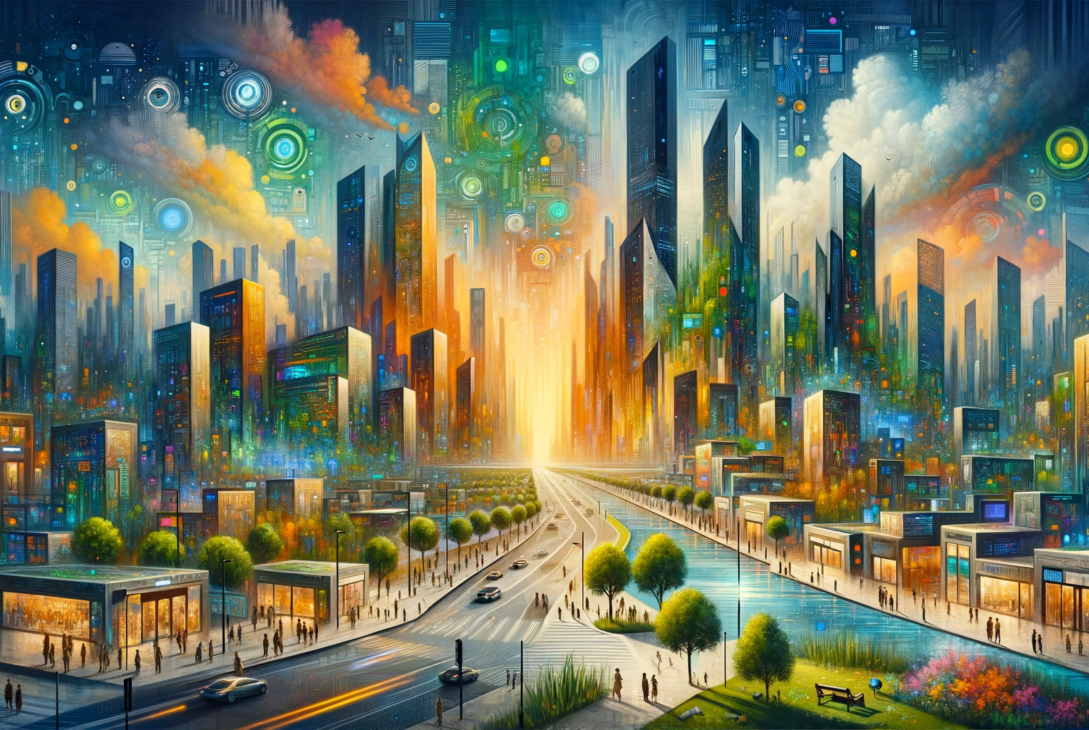Explore the groundbreaking realm of the Symbiotic City, where cutting-edge technology and living materials coalesce to redefine urban architecture. Delve into a futuristic vision where AI, smart materials, and biotechnology create dynamic, adaptive urban landscapes that seamlessly blend the natural with the technological, offering a sustainable, interconnected, and responsive environment for city dwellers.
The concept of the Symbiotic City represents a revolutionary shift in urban design and architecture, one where the integration of technology and living materials transforms the very fabric of city living. In these futuristic metropolises, buildings and infrastructure are no longer static entities but dynamic systems, infused with Artificial Intelligence (AI) and biotechnology. This transformative approach to urban design blurs the traditional boundaries between nature and technology, creating an adaptive, responsive environment that caters to the evolving needs of its inhabitants.
Artificial Intelligence in Urban Design
The cornerstone of the Symbiotic City is Artificial Intelligence. AI in urban architecture goes beyond mere automation and efficiency. It’s about creating structures that can think, learn, and adapt. Imagine buildings with AI-driven systems capable of self-regulation, optimizing energy usage, managing waste, and even adapting their form to suit changing environmental conditions and user needs.
AI systems in these cities would analyze vast amounts of data from various sources – weather patterns, human movement, traffic flows – to make real-time decisions. This data-driven approach ensures that the city’s resources are utilized efficiently, minimizing waste and maximizing comfort and convenience for its residents.
Smart Materials and Responsive Environments
The materials used in Symbiotic Cities are a far cry from traditional concrete and steel. These are ‘smart materials’ – substances engineered to change their properties in response to external stimuli. Shape-memory alloys, self-healing concrete, and photovoltaic glass are just a few examples.
In this scenario, a building’s exterior could change its shape or color based on weather conditions, enhancing energy efficiency or user comfort. Inside, walls could adjust their transparency or even their shape to create different spaces as needed. This adaptability extends to infrastructure as well, with roads and bridges that can self-repair or adapt to varying traffic conditions.

Biotechnology and Living Buildings
Perhaps the most revolutionary aspect of the Symbiotic City is the use of biotechnology in architecture. This involves integrating living organisms into the building’s fabric, creating structures that can grow, repair themselves, and even respond to the environment in a way traditional materials cannot. Through the use of bio-engineered materials like mycelium (fungus-based) bricks or algae-infused building panels, buildings could perform a range of functions traditionally handled by separate systems. They could purify air, produce energy, and even adapt their growth to provide better insulation or structural support.
Data Networks and Connectivity
The Symbiotic City relies heavily on interconnected data networks. These networks are the nervous system of the city, allowing for constant communication between various AI systems, smart materials, and biotechnological elements. Through advanced IoT (Internet of Things) devices, sensors, and actuators, every part of the city, from the tallest skyscrapers to the smallest park benches, would be capable of collecting data and responding to it. This creates a feedback loop where the city is continuously learning and adapting to the needs of its inhabitants.
The Dynamic Cityscape: A Closer Look
As we delve deeper into the technicalities, let’s consider a day in the life of a resident in the Symbiotic City. The building they live in is not just a shelter but a responsive organism. The walls and windows adapt to the external temperature, maintaining an optimal internal environment. If it’s a hot summer day, the exterior surface of the building reflects more sunlight, while in winter, it captures and stores solar energy.
The resident’s apartment can reconfigure itself. Need an extra room for a guest? A wall shifts, and a new space is created. The furniture, made from shape-memory materials, changes form to suit different needs throughout the day – a bed in the night becomes a sofa by day.
Outside, the streets are lined with bioluminescent trees – a fusion of natural and engineered life – providing energy-efficient lighting. The road surfaces repair themselves, and traffic lights are a thing of the past, with AI managing traffic flows seamlessly. In this city, public spaces are ever-changing. Parks can expand or contract based on the number of visitors. Buildings change their exterior displays to showcase art or information, creating a vibrant, ever-evolving cityscape.
Energy Systems and Sustainability
In the heart of the Symbiotic City lies its approach to energy – a paradigm of sustainability and efficiency. Renewable energy sources are seamlessly integrated into the city’s fabric. Solar panels are not just installed; they are the building skin, capable of photovoltaic energy generation. Wind energy is harnessed by elegantly designed turbines that blend with the cityscape.
The true marvel, however, lies in how these energy systems interact. Excess energy from one building can be redirected to another. Energy storage is sophisticated, utilizing cutting-edge battery technology or even kinetic energy storage systems. This interconnected energy web ensures a constant, sustainable power supply that adapts to the city’s fluctuating needs.
Water Management and Environmental Integration
Water management in these cities is a symphony of conservation and efficiency. Rainwater is not wasted but collected, purified, and reused. Buildings themselves act as water purification units, with living walls and roofs that filter rainwater for use within. Beyond conservation, the city’s water management systems are integrated into the environment. Wetlands and bioswales are part of urban planning, serving both as natural water management solutions and as green spaces for residents.
Transportation and Mobility
The Symbiotic City reimagines transportation. Public transport is not just efficient but adaptive. Autonomous vehicles communicate with each other and the city’s infrastructure to optimize routes and reduce congestion. Personal mobility devices, like e-bikes and scooters, are integrated into the city’s transport ecosystem, with AI-managed docking stations ensuring availability and charging. The layout of the city itself promotes walkability and cycling. The distances between places are optimized through adaptive planning, and green corridors provide safe and pleasant routes for pedestrians and cyclists.
Urban Agriculture and Localized Production
Urban agriculture is a key element in these cities, bringing food production closer to where people live. Rooftop gardens, vertical farms, and hydroponic systems are integrated into buildings, providing fresh produce while also contributing to the city’s air quality and biodiversity. Additionally, localized production extends to goods and services. 3D printing hubs and maker spaces allow for on-demand production of items, reducing the need for long-distance transportation and promoting a circular economy.
Social Spaces and Community Interaction
In the Symbiotic City, technology does not isolate but connects. Public spaces are designed to be adaptive, catering to various activities and community needs. Interactive installations, digital art displays, and augmented reality experiences are commonplace, enhancing the social and cultural fabric of the city. These spaces are also designed for inclusivity, with technology being used to ensure accessibility for all residents, regardless of age or ability. From navigation aids for the visually impaired to responsive environments for those with mobility challenges, the city is a space for everyone.
Data Privacy and Security in an Interconnected City
While this section does not delve into the ethics or legal frameworks, it’s important to acknowledge the technical challenge of ensuring data privacy and security in such a highly interconnected environment. Advanced cybersecurity measures are integral, with AI playing a crucial role in monitoring and responding to threats. Data is encrypted, and anonymization techniques are employed to protect individual privacy while still allowing the city to benefit from the collective data.
Conclusion
The Symbiotic City is a vision of the future where technology and nature coexist in harmony. It’s a place where buildings breathe, roads heal, and public spaces adapt to the needs of their inhabitants. In this city, technology is not an intruder but a facilitator, enhancing the quality of life and fostering a sustainable, resilient urban ecosystem.
As we conclude this exploration, it’s clear that the Symbiotic City is more than just a concept; it’s a roadmap for the future of urban living. It challenges us to rethink our relationship with technology and nature, urging us to envision a world where they work together for the betterment of humanity. In this vision of the future, the city is not just a place to live; it’s a living, breathing entity that grows, learns, and cares for its inhabitants.




